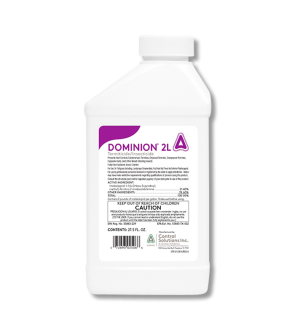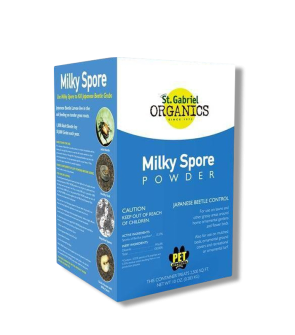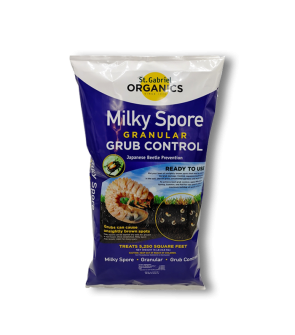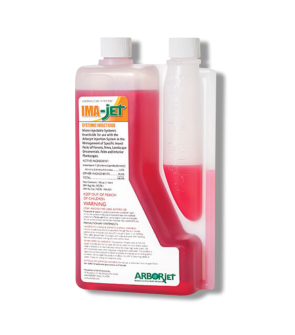Japanese Beetle Control
Most Effective Products
Japanese Beetle Control: How to Get Rid of Japanese Beetles
This page is an expert guide on getting rid of Japanese beetles from your property using the products and methods suggested by our experienced pest control specialists. Follow this guide and use the recommended products and we guarantee you will be successful in eliminating beetles.
Japanese beetles are one of the most widespread turf grass pests in the US, mostly found in the Eastern and midwest regions of the country. They can be an irritating nuisance to homeowner gardens due to the tendency for Japanese beetles to devour leaves and flowers from numerous types of plants.
Japanese beetle larvae, which are called white grubs, feast on plant roots and can create dead patches in the grass. Adult Japanese beetles are a metallic green and once they emerge from the ground in the late Spring or early Summertime, they will immediately begin feeding on to yard plants. It is because of these reasons that Japanese beetle control is necessary wherever they have set up shop.
If you are currently dealing with Japanese Beetles in your yard or garden, the following guide can help. Read on to learn how to get rid of Japanese Beetles using our professional product recommendations and expert techniques.
Identification
Before you can proceed with chemical applications and a treatment approach, you need to make sure that you are certain that you are dealing with Japanese Beetles. Proper identification can save you time and money by avoiding wrong treatment methods and products due to misidentification.

Here are some traits to help you to properly distinguish what a Japanese Beetle looks like:
- Adult Japanese Beetles range between 1/3rd of an inch to 0.5 an inch long.
- Their head and thorax region are usually a shiny metallic green while their wing covers are copper-colored.
- They have patches of white hairs at the ends of their backside and along the tips of their abdominal area.
- Japanese Beetle adults can be found inside of flowers feeding on petals and leaves or laying eggs in the grass around your yard.
- Japanese Beetle larvae are milky white-colored grubs with beige or brownish heads. Their bodies curl into a C-shape and they have visible legs.
- The grubs range between 1/8th of an inch up to 1 inch long and stand out from other white grubs with their hairy or spiny appearance.
- The larvae can be found in the soil of turf areas.
Use the image and description above to properly identify Japanese Beetles on your property. If you are not entirely sure, one of our representatives can help you with correct identification via live chat or over the phone.
Inspection
Once you have identified Japanese Beetles on your property, you will need to carry out an inspection to determine where the Japanese Beetles are laying their eggs, what plants they are damaging, and where they are generally congregating.

Where To Inspect
Focus your inspection outdoors in your yard and garden areas. Adult Japanese beetles readily feast on a wide variety of flowers, fruits and other plants. Scan around your yard, especially where there is damage done to your plants, you should also examine your turfgrass since this is where adult Japanese Beetles lay their eggs.

What To Look For
You're looking for adult Japanese Beetles, their larvae and any damage they have inflicted on your plants. Japanese Beetles have a huge appetite and where they are infesting, you are likely to see leaves eaten down to a skeleton and bite holes all over flower petals or fruit. Damage can also be indicated by browning plants and leaves.
As noted earlier, larvae look like worms with small hairs and can be found on the soil surface or underneath the soil. Something you can do to check for larvae is dig a small patch of turf and observe the soil for grubs.
Treatment
Once you have confirmed Japanese beetle activity, you can proceed with treatment. Remember that you must read all the product labels and follow the application instructions on these labels, and stay safe by wearing personal protective equipment (PPE).
The best way to treat for Japanese Beetles is to conduct a broadcast treatment of Dominion 2L to the active areas where you have noticed them. Dominion 2L is a neonicotinoid insecticide that works systemically to kill larvae that may be feeding on roots in the soil as well as kill adults on contact. It can be safely be applied to plants without causing any harm and will kill any Japanese Beetle that decides to eat treated turf and vegetation.
Step 1 - Spray Dominion 2L around Yard and Plants
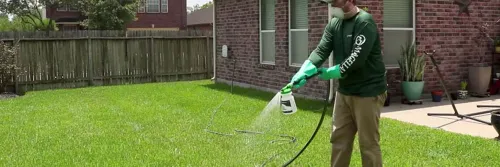
Determine how much Dominion 2L you will need to mix by first calculating the square footage of the area you wish to treat. To do this, measure (in feet) and multiply the area length times the width (length x width = square footage). Japanese Beetles should be treated at a rate of 0.46 to 0.6 fl. oz. in a gallon of water to treat 1,000 sq. ft.
We recommend using a 20-gallon hose-end sprayer for large areas to more efficiently treat the entire lawn. If you have a smaller residential area to treat, use a hand-pump sprayer. For hose-end sprayers, attach the spray nozzle to the hose and then add the proper amount of Dominion 2L to the reservoir with the correct amount of water.

For pump sprayers, fill the sprayer halfway with water, add the appropriate amount of Dominion 2L based on your calculations and then fill with the remaining half-gallon of water and agitate the sprayer until the product is well mixed.
Start from one end of the yard and work your way over the entire turf area, preferably on a fan spray setting for even coverage. Next, treat your garden plants, ornamentals and shrubs, spraying to wet but not to the point of runoff. Make sure to also spray the undersides of leaves, since Japanese Beetles like to hide in these areas. Apply on a calm day when wind speeds are low to minimize drift.
Prevention
After the Japanese Beetles have been eliminated from your yard, you will need to make sure it stays that way by putting in place some preventative measures to keep them away. This involves keeping your lawn healthy with a regular mowing, watering and general maintenance schedule.
- Rake your lawn regularly to remove thatch and expose the Japanese Beetle grub to its natural predators.
- Give your lawn 1 to 1.5 inches of water once a week and mow your grass at a height of 3 to 4 inches to encourage root growth.
- You should fertilize on a regular schedule to make sure your turf gets the nitrogen nutrition it needs to fight against pest symptoms.
- Reapply Dominion 2L on a quarterly basis every 90 days for continued protection against Japanese Beetle invasions.
Key Takeaways
What Are Japanese Beetles?
- Japanese Beetles are a notorious pest known for causing heavy amounts of destruction to turf, ornamentals and garden plants with their big appetite.
- Japanese Beetles lay eggs in turf that hatch out larvae in the form of white grubs. The larvae is known for damaging turf and causing dead patches.
How To Get Rid of Japanese Beetles In The Yard
- Treat your yard with a broadcast application of Dominion 2L. This is a systemic insecticide that targets both adult Japanese Beetles and their larvae, putting a stop to the damage.
- You can either use a hose-end sprayer (if you have a large area to treat) or a hand-pump sprayer for a smaller residential area.
Preventing Japanese Beetle Reinfestation
- Maintain a regular lawn maintenance routine by watering, fertilizing and mowing your grass at the right height (at about 2 to 3 inches).
- You can make preventative applications of Dominion 2L on a quarterly basis for continued control of Japanese Beetles all year long.

